.
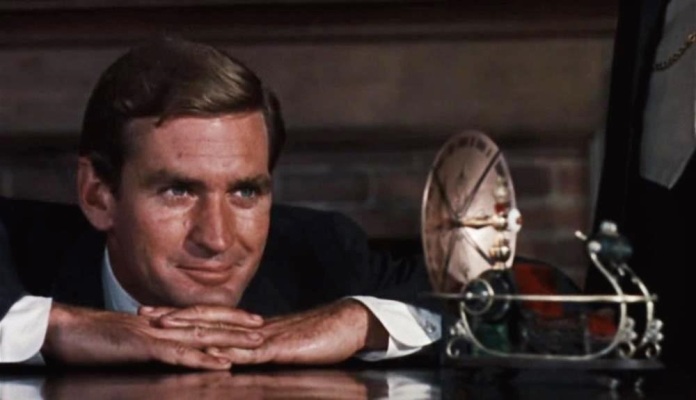
.
Director: George Pal
By Roderick Heath
The 1950s saw the first real boom in cinematic science fiction, and those genre halcyon days owed much to George Pal. The Hungarian-born filmmaker had made his name working in the German film industry before the Nazis came to power with a series of shorts linking music and a clever brand of animation he developed known as Puppetoons. After he moved to the U.S. and started working in Hollywood, he captured an Oscar for his shorts in 1943 before eventually turning to feature production with the 1950 fantasy film The Great Rupert, helmed by actor-turned-director Irving Pichel. Pal and Pichel quickly followed it up with a more ambitious project extrapolating cutting-edge scientific concepts, most of which were still purely theoretical, about what space travel would be like and turning them into a movie titled Destination Moon (1950). Not the best of the scifi work of the era and not quite the first, Destination Moon nonetheless renewed the template for a brand of realistic science fiction first touched on by Fritz Lang two decades earlier with The Woman in the Moon (1929), and proved the catalyst for an eruption of interest in all things fantastical and futuristic that would cram movie screens for the next few years. Pal, who seemed to harbour ambitions to emulate his Paramount Pictures stablemate, Cecil B. DeMille, as a maker of grandiose entertainments, soon produced two more works still familiar to anyone who loves the genre: When Worlds Collide (1951) and War of the Worlds (1953), based on the H. G. Wells novel. His brand came to grief with Conquest of Space (1955), an attempt to return to Destination Moon’s template of hard scifi that was generally rejected as hokey and clumsy, although now its ambition and fumbling attempts at a poetic understanding of space flight now look far more prescient.
.
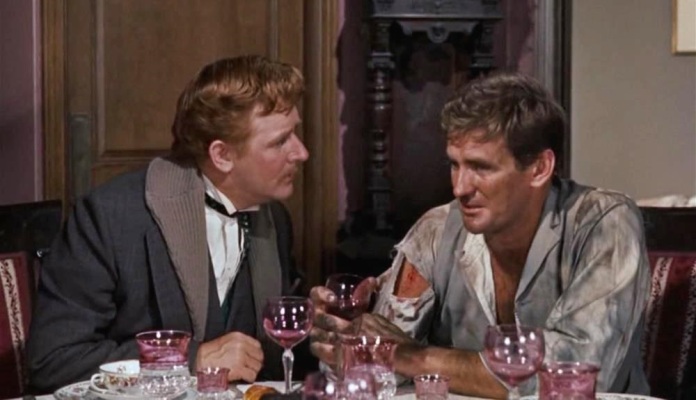
.
Pal didn’t make another film for three years, and when he did, it came as a straight fantasy for MGM, tom thumb (1958), with Pal himself directing for the first time. The film’s success allowed him to return to scifi with a second raid on the works of H. G. Wells, this time the 1895 novella The Time Machine. Wells’ role in shaping the very concept of science fiction is hard to overestimate. If his predecessors and fellow progenitors Mary Shelley, Edgar Allan Poe, and Jules Verne opened up the strange new landscapes of speculative interest, the former pair as a psychic vista of strangeness and anxiety, and the latter with a grasp on the potential of machinery, Wells synthesised their approaches and used his real scientific learning to start writing stories that investigated a certain driving idea to a logical end, with his real dramatic and poetic gifts used to shade and guide. Wells was eventually frustrated by the way his early, short, sensational writings overshadowed his more literary and philosophical output even before his death in 1945. His most famous tales also defied easy filming, as they tend to be shaped more like travelogues through certain conceptual universes rather than as propulsive narratives. Pal, however, had no problem overseeing their conversion into forceful blood-and-thunder yarns.
.

.
Partly for this reason, Pal’s approach to scifi has often been divisive for genre fans in spite of his films’ iconic status, as he popularised the form by emphasising elements general audiences could grasp and relate to at the expense of more radical aspects: When Worlds Collide and War of the Worlds are littered with invocations of the biblical and parochial in contrast to the more difficult, sceptical, acidic impulses scifi in its literary form was just starting to contemplate. Yet Pal and his various stable directors had a grasp on the essence of scifi in the popular mindset as a place of vast frontiers, grand promise, and outsized threat: When Worlds Collide and War of the Worlds successfully visualised the new awareness of the Atomic Age as a place of both possibility and dread in fervent colours and big-type dramatic reflexes. By 1960, the zeitgeist was changing, and Pal took on The Time Machine with a mellower, more thoughtful palate, if also still happily leaping into adventure territory when the time came. Pal saw scifi through the eyes of a man whose life had been shaped by his love of constructing and manipulating his Puppetoons, a modern take on an old mechanistic craft with its roots based on middle Europe’s folk cultures as a new-age wing of the old fairy tale book; unsurprisingly, his next work as director was to be an exploration of the legacy of the Brothers Grimm. The Time Machine manages to be both thoughtful and wistful, but also childlike in its sense of the possible and glee in the process of the impossible.
.

.
The film’s prologue, a series of gently ticking, drifting clocks in the void giving way to the drumming thunder of Big Ben, has a beguilingly poetic quality that infuses the rest of the film, which looks both backwards and forwards with both youthful joie de vivre and an autumnal sweetness. In this regard, Pal’s visuals are inestimably aided by Russell Garcia’s scoring, with sound and image in deep accord in exploring the way the past and the future are another country. As later transposers of Wells’ art would also do, Pal and screenwriter David Duncan wove Wells himself and his ideas into his tale, essentially presenting the anonymous time traveller of the book as Wells himself, or the version of himself he presented through his writing—a thoughtful dreamer and pacifist out of step with the coldly pragmatic mindset of the late Victorian age. Pal also reset the story at the moment of a great pivot, in the last week of the 19th century, charged with intimations of a farewell and a new beginning attendant to every change of year with the special dimension of one world about to give way to another. The book’s recounted narrative is retained, as kindly Scots merchant Robert Filby (Alan Young) and other members of a circle of friends, gruff Dr. Hillyer (a glorious character turn by Sebastian Cabot), boozy Bridewell (Tom Helmore), and stuffy Kemp (Whit Bissell), await dinner with their inventor friend George Wells (Rod Taylor) in his house. Increasingly irked by George’s absence, the men sit down to dinner served up by the housekeeper, Mrs. Watchett (Doris Lloyd), only for George to appear, bloodied, shattered, and dishevelled.
.
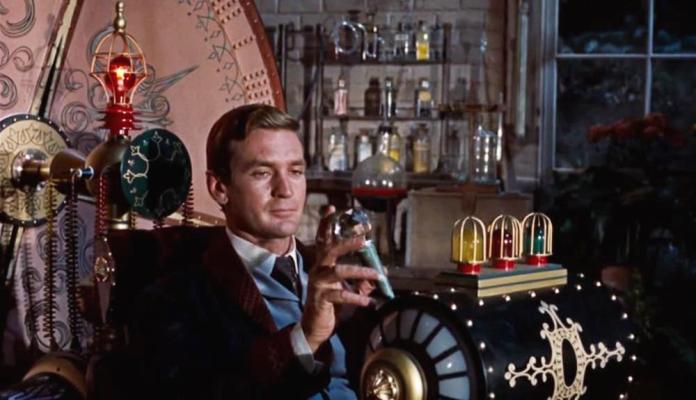
.
George, fortified by wine and Filby’s assurances that he has “all the time in the world,” begins to recount the strange adventure he’s had since he last talked to them. A flashback takes them to their last meeting, on New Year’s Eve, during which George tried to thrill and impress his friends with a demonstration of a miniature version of a time machine he’s built. The small machine seemed to work perfectly, but his friends chose to dismiss it as a conjuring trick. Hillyer and Kemp instead prodded George to turn his efforts towards more practical ideas to serve military applications, whilst Filby feared the machine on a more fundamental level, warning his friend that it’s not a good idea to tempt the laws of providence. Frustrated by their lack of belief and understanding, and appalled by more grim news from the Boer War, George arranged for the dinner a week in the future before heading to his laboratory and climbing into the full-sized version of the time machine, determined to brave all dangers and explore the future in his conviction it will prove to be the place where his dreams become common reality.
.
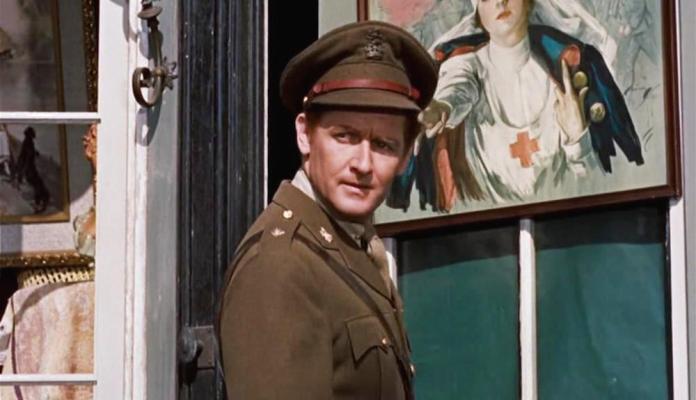
.
The Time Machine chose to take on its source novel in the period during which it was written and employ the odd and fascinating spectacle of super-sophisticated machinery built in a Victorian fashion. In doing so, The Time Machine’s eponymous creation, a glorious thing of brass curves, plush red velvet and blinking multicoloured lights, became one prototype for the subgenre today called Steampunk. The Time Machine wasn’t the first work to render a scifi classic in period, as a handful of Verne adaptations in previous years—Richard Fleischer’s 20,000 Leagues Under the Sea (1954), Byron Haskin’s From the Earth to the Moon (1958), and Henry Levin’s Journey to the Centre of the Earth (1959)—had already exploited the charm and colour of retro conceptualism. But that choice was more felicitous in making The Time Machine because of the nature of its narrative and its themes, and because although submarines and spaceships now existed, the idea of a time machine could still be illustrated in a charmingly vague way. George’s time travels didn’t have to be entirely imagined, and the contrast between his ideals and the reality of the new scientific age could be described, with an extra dimension of introspection from a 1960s perspective.
.
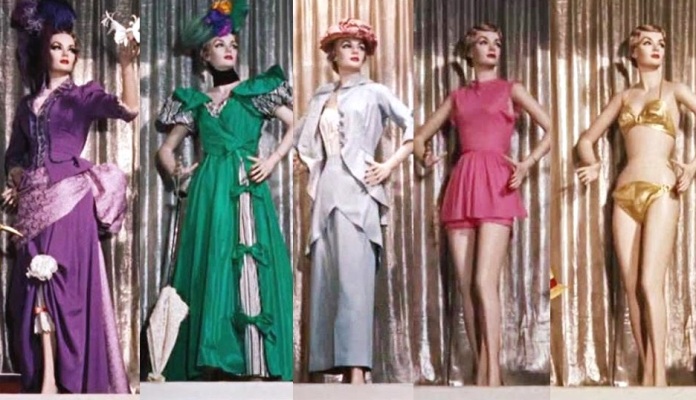
.
First and foremost, George’s plunge into what he calls “the fourth dimension” is both illustrated by and analogous with Pal’s own love of ingenious showmanship, visualising time travel through the basic building blocks of cinema itself—stop-motion and time-lapse photography—and replete with good-humoured flourishes, like the mannequin in Filby’s store window who becomes George’s unageing friend and barometer of shockingly changing tastes in fashion. George’s first stop in future time brings not just the chuffing oddness of a horseless carriage, but also a harsh taste of loss, as he sees Filby wearing a military uniform, only to learn to his sorrow that this is Filby’s grown son James (Young again), whose father has died in the trenches of World War I. George takes away one salve: Filby, who controlled George’s estate, refused to sell the house out of faith that one day George would “return.”
.
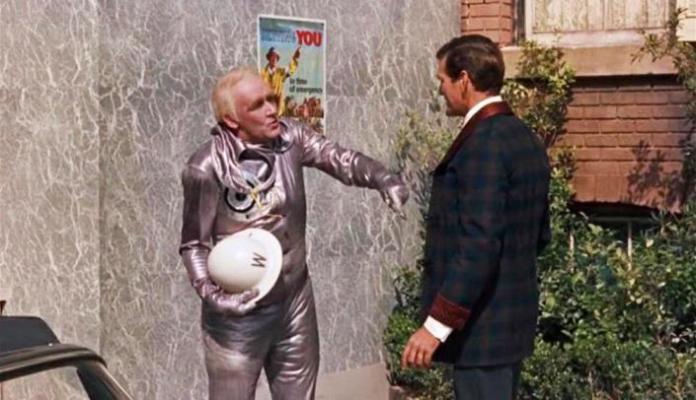
.
George despondently returns to his machine and presss on, experiencing his house’s destruction during the Blitz before stopping again presumably in the later 1960s, when atomic war has broken out. Again George is confronted by the sight of people fleeing to air raid shelters, and again meets James Filby in a military role, only this time he’s a silver-suited, white-haired air raid warden urging people to safety, astounded by George’s youthful appearance. The sight of an atomic missile drives Filby away even as Geroge begs him for conversation, and George barely survives the horror of an atomic explosion and the volcanic eruption it sets off. He climbs into his time machine and just manages to avoid being roasted by lava. Instead, he is walled inside a rock form for millennia. When the rock wears away, he surveys a marvellously new green Earth where a sublime harmony seems to have evolved between human structures and the elements. He stops his machine suddenly, causing it to careen out of control, topple over and knock George out. He awakens to find himself close to a strange, Sphinxlike building, and when he begins to explore the landscape, finds it an Edenic place with apparently no one to share it, the huge, super-moderne buildings nearby uninhabited and run down. Finally, he does encounter other people, a bunch of wan, blonde, innocent and yet also almost pathologically indolent folk who call themselves the Eloi. George has to save one woman he sees close to drowning in a river under the blasé gaze of her friends. George makes the acquaintance of the woman, who says her name is Weena (Yvette Mimieux), and slowly begins to plumb the strangeness of the society he’s presented with.
.
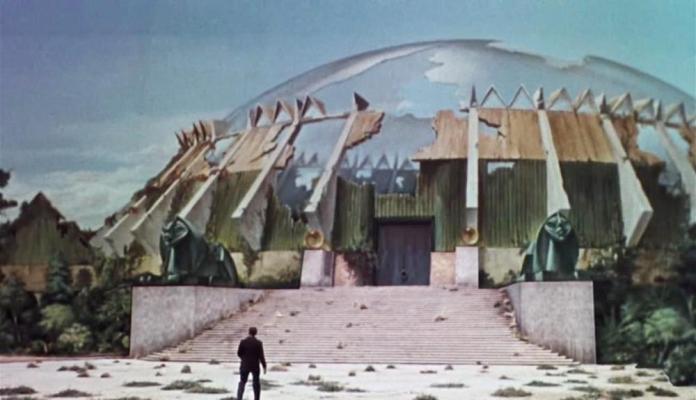
.
The greatest qualities of The Time Machine become apparent in George’s headlong journey through time, experiencing his own erasure from history, the death of friends, and the calamities awaiting humankind thanks to our inability to learn lessons, all with steadily drooping enthusiasm. Pal grasps intuitively the action of time travel not just as discovery, but also as tragedy, as George finds himself doomed to witness looping events and scenes of loss and destruction, until finally, when the rock encasing him and his machine breaks apart, he seems to behold a gorgeous new future. But there are also peculiar proofs of faith, as when George finds that what was his old house has been turned into a park dedicated by James to his father’s love for his friend. There’s a striking intimacy and humanity to much of the film, for example, when George realises Filby has remained behind after his disappointing demonstration to talk, or George’s interactions with Weena, who gropes towards an understanding of him and the apple of necessary, but painful knowledge he brings to her Eden. When he arrives in the future he so dearly wants to see, his pleasure in what he sees is steadily worn down to a state of furious disillusion: the underlying truth about the Eloi and the strange beings that lurk in the darkness they call the Morlocks eventually proves utterly horrifying, but, in a way, less depressing to a man like George, who finds himself shocked and outraged when he finds the Eloi have allowed what’s left of the human intellectual inheritance to petrify and crumble away as they live happily in the sun eating the bounties provided to them without question or heed.
.
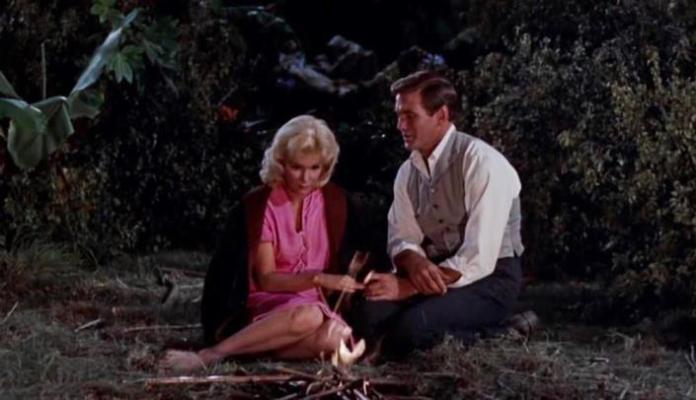
.
Wells set out with The Time Machine to disassemble the precious, barely questioned idealism of the high Victorian period, an idealism that had much in common with the 1950s variety—an official faith in the future with a vibrating anxiety over change and threat beneath it all. He took the still fresh and prickly notion of evolution, whose great proponent, Julian Huxley, had been one of Wells’ teachers, and applied it mirthlessly to the satirical idea that if allowed to continue, the stratification of society would eventually lead to two entirely different posthuman species, the Eloi, descendants of a leisure class, and the Morlocks, subterranean workers who, in a twist of brute sarcasm, have become farmers treating the Eloi as free-range cattle and living on their flesh. Pal and Duncan tweaked this concept to look squarely at the idea not just as a permutation of Victorian labour relations, but also as a distant echo of life in the 20th century: the Morlocks round up their flocks of Eloi by blasting out the sounds of air raid sirens that draw the Eloi underground. The Eloi have essentially become children, afraid of the dark and blithe about what supports their lifestyle, but George’s arrival quickly coaxes deeper reflexes from Weena. She braves the terrors of the night to warn him about the Morlocks as he searches for his machine, which he finds has been dragged within the Sphinx. George and Weena spend a night hunkered before a fire after one of the Morlocks has attacked her, but fortunately, the monsters prove vulnerable to bright light and a good right hook.
.
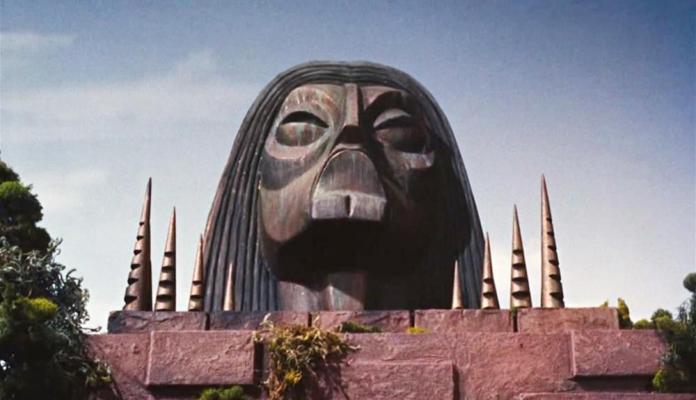
.
The Time Machine treads campy territory in trying to present the Eloi like a mob of listless, young Hollywood ingénues and beach bums (that Mimieux also starred in the same year’s Where the Boys Are amplifies the association), whilst also interestingly prescient on the oncoming age of the counterculture and its history-reboot philosophy, a movement which had much in common with the onset of many similar ideas in the Victorian age that Wells himself often espoused. There is stinging power in the moment when George, led to a collection of books kept by the Eloi by one of their number, realises the Eloi have let their cultural inheritance decay and literally turn to dust, and the previously idealistic and forward-looking savant is appalled and disillusioned to a crushing degree: “At least I can die amongst men!” he bellows in offense before abandoning his attempts to plumb the Eloi culture, because there is none. It’s also hard to deny that on at least one level, the film devolves into a Boy’s Own tale of two-fisted adventure and revolt as George proves the threat of the Morlocks is only as strong as they’re allowed to be. But the future sequences of the film have a similar mood of stripped-down mythos that would later sustain definitive genre TV works like Star Trek and early Doctor Who. In this regard and more, The Time Machine feels like a vital transitional moment in scifi cinema, mediating the chitinous forms of ’50s scifi and the brand that would dominate for the next 15 years or so in English-language scifi filmmaking—looking more closely at human society, its past and present, through the prisms of parable.
.
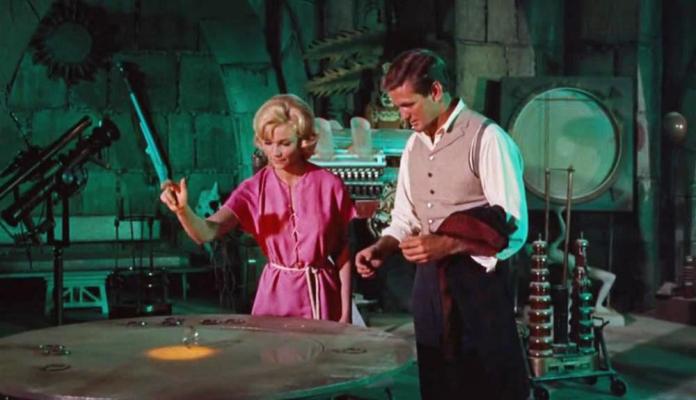
.
The soul-searching that often bubbled as subtext in ‘50s scifi films here hatches and becomes overt, contemplating the modern inheritance both as one of wonder, but also cringing fear of what terrors it had conjured. The Eloi living space has the quality of being at once futuristic and distantly mythical. The drama turns inward as it contemplates humanity’s fate with an early intimation of the idea of dystopia, a substrata of the genre that’s still powerful, often playing out in extrapolated versions of high modernist architectural environs and evoking common pasts as decayed and neglected memories, and plied with a dusting of fable as here, including the likes of THX-1138 (1971), Zardoz (1974), Rollerball (1975), and Logan’s Run (1976). The headier, questioning aspect of the film seeds many more genre directions, not the least of which was the time travel idea itself, one barely tackled in cinema before this, but which has become an oft-iterated theme in works as diverse as Back to the Future (1985) and Primer (2004). The haunting quality Pal manages to invest in the film continues to recur, especially powerful and poignant in the sequence when Weena leads George to a place where the remains of human civilisation still persist, the voices of men in ages past recorded on spinning rings reporting tales of bleak decline and death; pointedly, both voices heard are Paul Frees, who had loaned his stentorian tones to War of the Worlds as the definitive voice of futurism, now reporting as the ghost of ages lost in a sublime distillation of the scifi creed in a totemic moment: “My name is no consequence. The important thing you should know is that I am the last who remembers when each of us, man and woman, made his own decision.”
.

.
The lingering shadow of the ’50s monster movie still pervades The Time Machine, as the glowing-eyed Morlocks try to snatch Weena. But Pal still manages to generate a weird and tense atmosphere, as when George witnesses the Eloi responding to the Morlock siren call and then descends into their underground works to rescue Weena and in a gleeful action climax as George battles the cannibalistic, humanoid Morlocks, having discovered the gruesome secret in a room littered with human bones by exploiting their great weakness, their fear of bright light. A particular likeness has long intrigued me about this sequence and the way it connects to Pal’s earlier career and background: Garcia’s music in places sounds awfully reminiscent of Igor Stravinsky’s score for his famous ballet The Firebird, suggesting Pal might well have taken inspiration from that work and its roots in Slavic and Hungarian mythology, and evoking Pal’s own musical reflexes from his Puppetoon days. Certainly Pal had long been fascinated with the classic battery of fairy tales and had adapted several as shorts. This connection makes perfect sense to me, as the story is essentially the same, with George cast as the pure hero descending into a stygian underground to fight the demons and steal back a captive princess, fending off evil with light, and the time machine itself cast as the firebird, the vessel of transformative power. And as silly as George’s battle with the Morlocks is in a way, it’s still a genuinely gripping sequence with a great physicality, particularly as Pal’s eye is strong here, with the nightmarish image of the Morlocks advancing on their penned-up intended meals. The film’s corniest moment is also a highlight—an effete Eloi mans up and wallops one of the Morlocks in the back as it throttles George, saving his life.
.

.
A few good socks to the jaw and some fiery brands fortunately prove enough to give the Morlocks hell, being as they are used to victims who don’t fight back. George is able to rescue Weena and some of the other Eloi, blowing up part of the underground city, and a new dawn seems at hand. But the Morlocks set a trap for George, luring him into the Sphinx with his time machine and then closing the doors, separating him from Weena and forcing him to fight for his life before he manages to escape in time, first travelling forward, witnessing the gruesome decomposition of a Morlock he killed, a surprisingly graphic and spectacular visual punch for 1960. George finally returns to his own time to keep his date with his friends. His only proof for his story is a flower given to him by Weena, and again he is disbelieved, taken by his friends as an attempt to break into the penny dreadful market.
.

.
At the last, Filby hears the time machine revving up again after George has dragged it back in from the garden and repositioned it in the laboratory so he can reappear outside the Sphinx before Weena. It’s appropriate that the last notes of The Time Machine return to that mood of wistful longing and questioning as Filby is left contemplating his friend’s resolve when he and Mrs. Watchett notice George took three books to the future with him, leaving it up to the audience to divine which three books they were. This provides a lovely little supernal flourish that closes off the film on just the right note, again nudging the fablelike with the tiniest signs of human nature—a flower in Filby’s hand, a space on a bookshelf, the lights switching off in a house whose owner will never return, and a man shuffling off in the snow back to his family—proffered as transcendental totems.
The cast of the film lived long and well. When Rod Taylor and more recently Alan Young died, I could not help but think, “You have all the time in the world.”

Nice writeup, and it’s a fun movie, I used to always watch it when it showed up on some cable channel or other, has that re-watchable thing about it. I vaguely recall from the book that he goes to the end of life on earth, when it’s cold and the sun is large and he’s by the seashore, I thought that would be some neat imagery for the movie. I also think the time scale used in the book for the end of the world was not scientifically accurate, probably was based on the science of Wells’ time. I suppose that dramatically speaking such a thing would just derail the pace and focus of the movie.
LikeLike
“The film’s prologue, a series of gently ticking, drifting clocks in the void giving way to the drumming thunder of Big Ben, has a beguilingly poetic quality that infuses the rest of the film, which looks both backwards and forwards, with both youthful joie-de-vivre and an autumnal sweetness. In this regard Pal’s visuals are inestimably aided by Russell Garcia’s scoring, sound and image in deep accord in exploring the way the past – and the future – are another country.”
Love these magnificent observations Rod, though so many other points like the one sizing up the central setpiece as “retro concepualism” and the crossing of other genres like horror in a film always seen as a quintessential work of science fiction in film and literature. Yes as you do reluctantly concede this is not remotely a perfect film – I see some of it now as cheesy- but it is still wholly irresistible, and it does project that poetic quality you pose so persuasively. This was a huge favorite from my childhood and I did see it in the theater. Yes time travel has worked more successfully in other films and in some of the great television series from the 60’s/70’s like “Twilight Zone,”Night Gallery,” “The Time Tunnel,” and “Star Trek.” The latter’s original series produced my own time travel screenplay “The City on the Edge of Forever” with Joan Collins as guest star.
But this is the original and it is so fondly remembered. The review here is definitive.
LikeLike
Sam – I think you may be remembering “The Time Tunnel” though rose colored, uh, well, you know what I mean. I think my 12 or 14 year old self, however old I was, even then didn’t think too much of it. Neat idea, weak execution.
LikeLike
Excellent reflection on “The Time Machine”, Rod.
I saw “The Time Machine” in 1960 when I was eleven. It was a time when you could walk to the neighborhood “theater” and didn’t have to be driven to a cineplex. My little brother and I regularly walked to the movies unattended. There was a basic trust that you were safe in the community. The movie house was often packed with kids without parents. Today, a parent would be visited by a member of DCYF for letting their children go to the movies by themselves. Talk about time travel!
When George stops the time machine in 1966, a nuclear attack is underway. This part of the story frightened me to the depths of my soul. Living during the height of the Cold War, I had always prayed that nuclear (“atomic”) war would be avoided. Now, here was a prediction that in six more years, we were going to be history!
Thanks.
LikeLike
Patrick, I don’t know why Pal chose to excise the journey to the future. Perhaps expense was a factor too. But I suspect as you do that perhaps because it would have cut against the more positive note he wanted to strike.
It’s been ages since I watched any of The Time Tunnel, but I remember it as quite a fun if lightweight show, like most Irwin Allen’s stable of scifi series, more substantial than Lost in Space but not quite as fervently weird as Land of the Giants; it’s chiefly that grand central set that lingers in the imagination. I tend to find it telling that such series usually tended to end up in the same places, like the ‘80s series Voyagers which I saw as small boy, which managed to send its characters onto the Titanic just like The Time Tunnel.
Frank: hell, that bit disturbed me as a kid many years later. I particularly like the use of sound – the eeriness of the air raid warnings, James’ totemic phrase “The mushrooms will be sprouting!” I wonder if it’s the first actual depiction of nuclear war on a populated area in a mainstream film.
LikeLike
Pal wanted to do a sequel, but due to his age the studio didn’t want to trust him or fund him to do it. in the magazine Star Log they had some story boards on scenes from the production. Pal wanted to get the original cast back too.
It would include that trip to a much further future with a swollen sun and the arthropods rule the Earth again and lichen forests to feed on as it gets nippy.
There is a second novel concerning When World’s Collide with humanity finding deserted, intact, advanced cities on the planet that will take Terra’s place in orbit. I had hoped that George Pal would have exploited it in a sequel to his film.
LikeLike
I don’t think The Time Machine really needed a sequel but a When Worlds Collide one might’ve been fun.
LikeLike